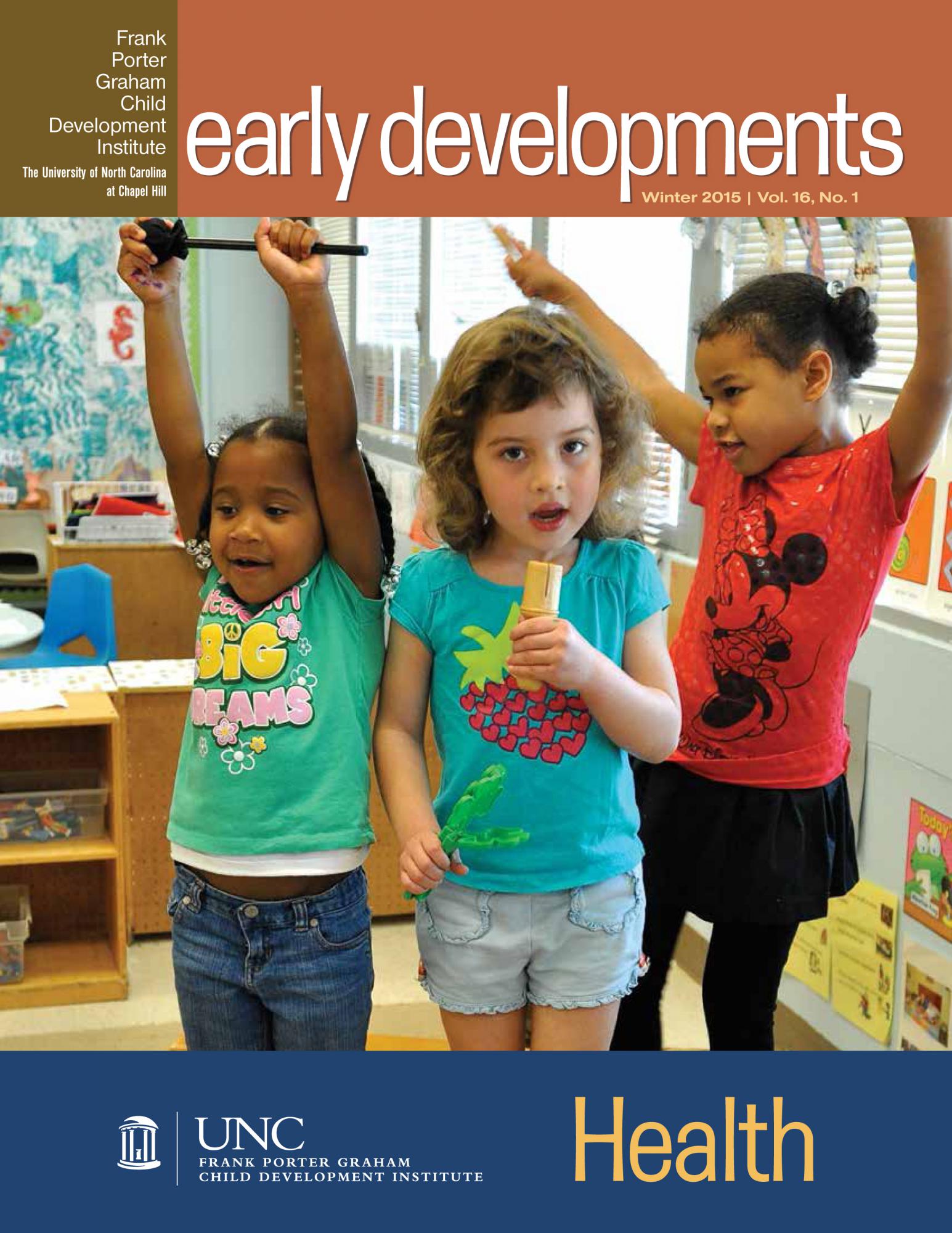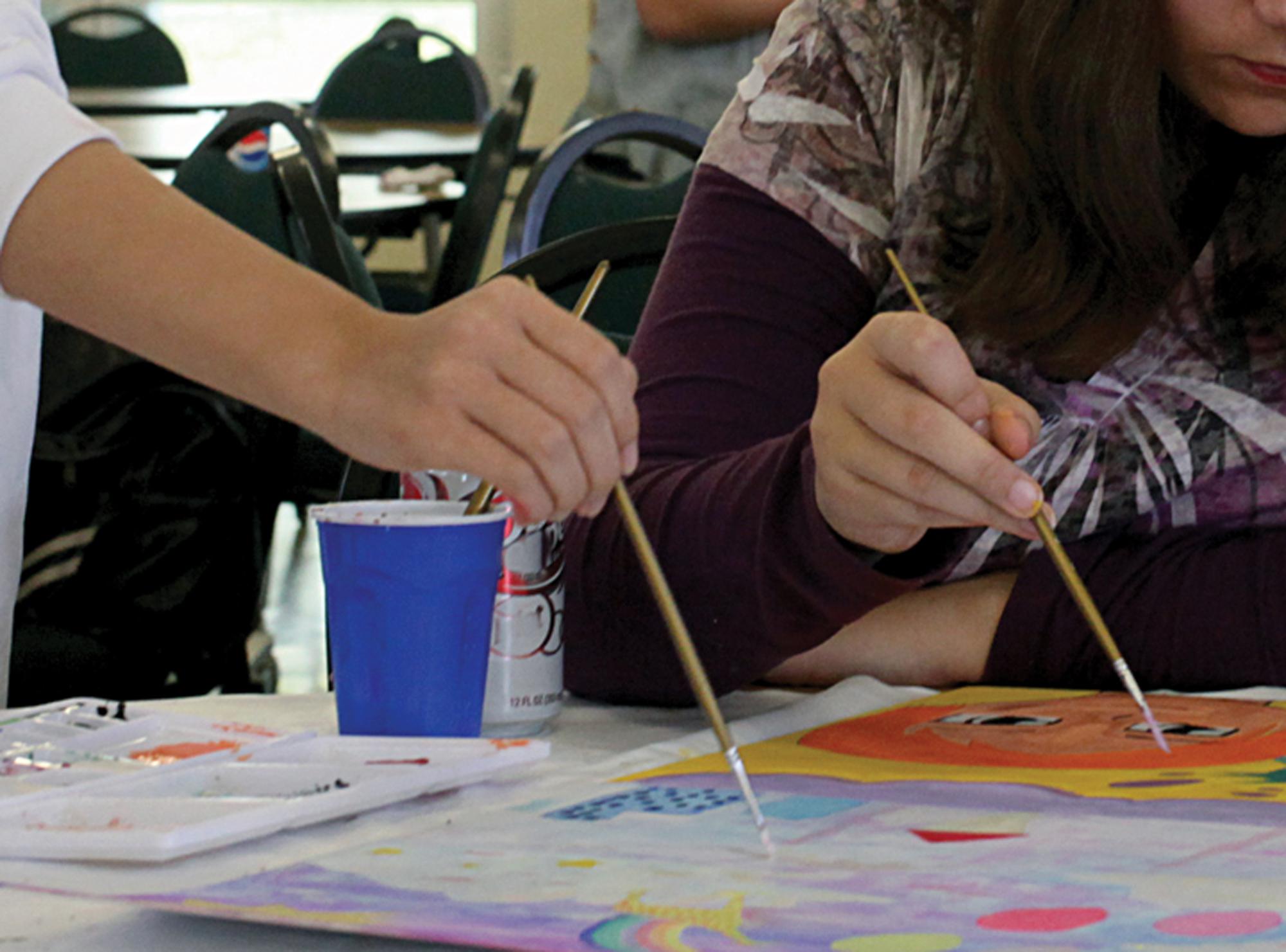Social Health: Children and Youth with Autism Spectrum Disorder
 from the Winter 2015 issue of Early Developments: Health
from the Winter 2015 issue of Early Developments: Health
Never before has FPG directed such a comprehensive array of initiatives to help improve the social health of children and young adults with autism spectrum disorder (ASD). Toddlers to high school students are benefiting from research, programs, and resources that support their families, providers and educators, school administrators, and policymakers. What follows here are two stories and many short glimpses of FPG’s commitment to meeting the needs and supporting the strengths of children and youth with ASD.
Hope After High School
An innovative program from FPG and six partner universities is preparing students with autism for life after high school.
“Public high schools may be one of the last best hopes for adolescents with autism—and for their families,” said FPG director Samuel L. Odom. “Many of these students will face unemployment and few social ties after school ends.”
While teachers and other professionals in the schools work hard to achieve beneficial results for students with ASD, positive outcomes remain elusive, given the scarcity of specific programs for these students available in high schools. To fill this gap, Odom and other scientists formed the Center on Secondary Education for Students with Autism Spectrum Disorder (CSESA).
“We developed our approach from research in several fields,” said Odom, CSESA’s principal investigator. “Because of the complex educational needs of many students with ASD, it was important to develop a comprehensive program for high schools.”
In several high schools, CSESA focuses on understanding emotions, developing friendships, and social problem-solving. Early results at a high school in the Raleigh-Durham, North Carolina, area show that student groups designed to bring together adolescents with and without ASD have helped them engage with one another more often.
“Even a simple hallway ‘hello’ between students with autism and their peers is more likely now,” said Kara Hume, CSESA’s project director and co-principal investigator.
CSESA also addresses literacy skills, which can be limited in many students with ASD. At Myers Park High School (MPHS) in Charlotte, N.C., the program helped with Christopher Stickell’s inclusion in an English class.
 “Not only did my son have access to a wider world than his self-contained classroom, but the students in the English class had some of their pre-conceived notions about autism shattered,” said Lois Stickell. “Many were surprised when Chris read aloud a passage from Julius Caesar.”
“Not only did my son have access to a wider world than his self-contained classroom, but the students in the English class had some of their pre-conceived notions about autism shattered,” said Lois Stickell. “Many were surprised when Chris read aloud a passage from Julius Caesar.”
“We help develop basic high school survival skills,” Hume said, adding that another cornerstone of the program is its emphasis on promoting responsibility, independence, and self- management.
According to Odom, many teens with ASD continue to live with their parents after high school. “Not surprisingly, parents worry about the future as they anticipate their child’s transition out of the public schools,” he said.
“CSESA has provided opportunities for greater collaboration and relationship building with the families who have attended ‘Transitioning Together’ sessions,” said Phyllis Alston, an exceptional children teacher at MPHS. Each week, CSESA staff and school district personnel lead these discussion groups with families.
“We became aware of resources available that without CSESA we may not have been made aware of,” said Faith Hamilton, whose teenager will be attending Central Piedmont Community College in the fall to study photography. “My son gained confidence and his grades improved this year.”
According to Odom, built into the CSESA program’s design are features that help to install it quickly and successfully, such as “autism teams,” which spearhead efforts within the schools. The program also uses coaching to provide feedback on new practices as teachers implement them.
Although most complex programs may take 5 to 7 years to put into place, Odom said schools in North Carolina and five other states began using CSESA’s approach within weeks, and he projects that they will be administering the program on their own within 2 1⁄2 years.
“CSESA will expand to 60 more schools over the next 3 years,” he added. “We hope a lot more students with autism spectrum disorder will be able to leave high school better prepared for the challenges they’ll face.”
“Tried and True” Strategies for Children with Autism
 Earlier this year, the National Professional Development Center on Autism Spectrum Disorders released its much-anticipated update on evidence-based practices for children and youth with autism. FPG scientists spearheaded the project, screening 29,000 articles about ASD to locate the soundest research on interventions for children from birth to age 22.
Earlier this year, the National Professional Development Center on Autism Spectrum Disorders released its much-anticipated update on evidence-based practices for children and youth with autism. FPG scientists spearheaded the project, screening 29,000 articles about ASD to locate the soundest research on interventions for children from birth to age 22.
“More children than ever are being diagnosed with autism,” said FPG director Samuel L. Odom, who co-headed the new review. “We’re catching them earlier, with better tools, and these children need the right services.”
“Some interventions may seem cutting-edge, but we don’t yet know if they have any drawbacks or trade-offs,” said FPG investigator Connie Wong, who co-headed the new review of research. “Our report only includes what’s tried and true.”
Kristine Ganley and Karen Berlin, training and technical assistance providers at George Mason University, heavily rely on the NPDC’s reports on evidence-based practices to help people seeking professional devel- opment. “We don’t provide training on practices not included on it,” said Berlin.
According to Ganley and Berlin, before the NPDC published its comprehensive reviews of research, interventions for children with autism were much more controversial. “Internet searches re- turned as many different approaches as authors behind them, and mastery of any practice was rare,” said Ganley.
“If there was no reliable report on evidence-based practices, intervention would be based upon myths,” added Berlin.
Applying more stringent criteria, the NPDC’s new report drops one evidence- based practice from the 24 identified in its 2008 review. After considering more studies this time, scientists also renamed and broadened one category, “technology-aided instruction,” and added five more, including “exercise” and “structured play groups.”
“Expanding the list offers more tools to educators and service providers,” said Ganley. “This improves outcomes for children with ASD.”
Not only does the NPDC’s report provide guidance for professionals, it also is an essential tool for families. “Parents often pay for interventions that have no evidence behind them, but this report will allow them to make the best choices,” said Odom.
For Allison Smith, the Pawtucket, R.I., mother of identical twin 4-year-old boys with autism, the NPDC reports have helped her to advocate for her sons’ services.
“Knowledge is power,” Smith said. “Knowing what works has given us the upper hand in acquiring appropriate therapy and tools.”
According to Smith, video modeling, a longtime evidence-based practice from the NPDC’s list, helped her boys learn how to blow a feather. Develop ment of this key motor skill is often associated with the ability to speak.
“They couldn’t learn how to blow a feather until they watched their older brother doing it on video,” she said, even though therapists had been work- ing face-to-face with the boys on the task for months. “But it only took a few viewings of the short clip before the twins got it.”
“Being able to research the practices and then try them took a lot of guess work out of the process,” said Smith. “If there was no review of evidence-based practices, a lot of children would be without the interventions and services that are most appropriate for them.”
More on Children and Youth with Autism Spectrum Disorder
The following short descriptions of research, resources, and projects provide glimpses at more of the broad and diverse work at FPG on behalf of children and youth with ASD.
Resources on ASD through FPG’s Professional Development Center (The PDC@FPG)
In addition to intensive workshops on Using the Autism Program Environment Rating Scale with Proficiency, the PDC@ FPG delivers free online instruction on such topics as the early identification of ASD.
Family Adaptation to Fragile X Syndrome (FXS)
With former FPG director Don Bailey, FPG senior scientist Debra Skinner has helped lead research at the Fragile X Syndrome Research Center, which focuses on family adaptation to FXS—a genetic condition that causes a range of developmental problems than can include features of autism spectrum disorder.
Recognition for FPG’s Study on Autism Treatments
An annual list of scientific studies that represent significant progress has named FPG’s groundbreaking research comparing the TEACCH and LEAP models as one of the field’s top 20 advances.
Evaluating Parent-Mediated Interventions for Toddlers with ASD
Many novel scientific challenges confront rigorous research evaluating the effectiveness of programs for toddlers with ASD.
Joint Attention Mediated Learning Intervention for Children with ASD and their Families
This study looks at parent-child engagement during toddlers’ play sessions within their homes.
Concurrent Validity of Autism Symptom Severity Measures
Several screening and diagnostic measures for preschool-aged children include an assessment of symptom severity, and this study determined three such measures to be reliable and valid.
 New Implications for Use of The Classroom Practice Inventory
New Implications for Use of The Classroom Practice Inventory
The Classroom Practice Inventory (CPI) was developed as a tool to provide descriptive information about the practices used to address the developmental needs of children with ASD, and new findings from its use in preschools indicated the CPI produced reliable and valid assessments.
Improving Social-Communication and Engagement of Elementary Students with ASD
Social-communication is a key area of need for children with ASD, and this new FPG project is studying the first-time application in elementary schools of an intervention designed for public preschools.
New Implications for How Activities May Be Categorized for Children with Autism
A new study suggests that child characteristics and maternal education affect the frequency of specific activities of children with autism.
A Pioneering Curriculum for Teachers of Students with ASD
To help meet students’ needs and appreciate their strengths, FPG designed ready-made, flexible resources for school districts to support professional development for teachers.
Introducing Students with High Functioning Autism to Peer Social Networks
This FPG study examines the effects of peer social networks on social interactions, frequency of victimization, and friendship development for high school students with High Functioning Autism (HFA) or Asperger’s Syndrome.
An Action Plan for High Schools: Voices from Key Stakeholders
Four critical issues have emerged, each of which research has identified as essential to address in order to promote optimal outcomes for students with ASD.
The Roles and Needs of Families of Adolescents with ASD
Supporting transition-age students with ASD and their families requires a better understanding of the unique roles and needs of families, as well as implementing practices that can best ensure family involvement and enhance post-secondary outcomes.
 Keys to Independence after High School
Keys to Independence after High School
Research shows that independence is the biggest indicator of which students with autism spectrum disorder are likely to live on their own, have a job, and participate in their communities after high school.
Equipping Youth with ASD for Adulthood
An emphasis on promoting “rigor, relevance, and relationships” within a comprehensive transition framework for students with ASD is important for improving in-school and post-school outcomes.
TV Journalist Dwayne Ballen’s Keynote at the 2014 Inclusion Institute
When journalist Dwayne Ballen delivered his keynote address at FPG’s National Early Childhood Inclusion Institute, the former network sports anchor spoke about how his son Julian’s inclusion was especially important, because high-functioning autism meant Julian knew he was different.
New Case Studies on Evidence-Based Practices for High Schoolers with ASD
FPG’s Center on Secondary Education for Students with Autism Spectrum Disorder developed these case studies on visual supports, self-management, and prompting to support the learning of service providers working with high school students with autism.
New Guide for Teachers Facing the Spike in the Rate of ASD Diagnoses
Scientists at FPG and the Organization for Autism Research have released a multimedia manual that provides strategies for secondary school teachers whose classrooms now include students with ASD.
Strategies for Teaching Common Core to Teens with Autism
High school students with autism can learn under Common Core State Standards, boosting their prospects for college and employment.
Quick Advances through Video Instruction for Teens with Autism
Difficulty with social situations hinders the relationships, schoolwork, and mental health of teens with autism, and often these students struggle with complicated interactions in high school. Scientists from FPG and Michigan State University say that iPads and video-based instruction may change all that—and save schools money.
Promoting Social Competence and Peer Relationships for Adolescents with ASD
This two-page research snapshot examines numerous avenues that offer promise for strengthening the social competence and peer relationships of students on the autism spectrum.
Evidence-Based Practices for Saudi Children and Youth
Working with professionals from the Centre for Autism Research in Riyadh, Saudi Arabia, FPG is helping to establish and promote high quality programs and evidence-based practices for learners with ASD and their families.
DS
